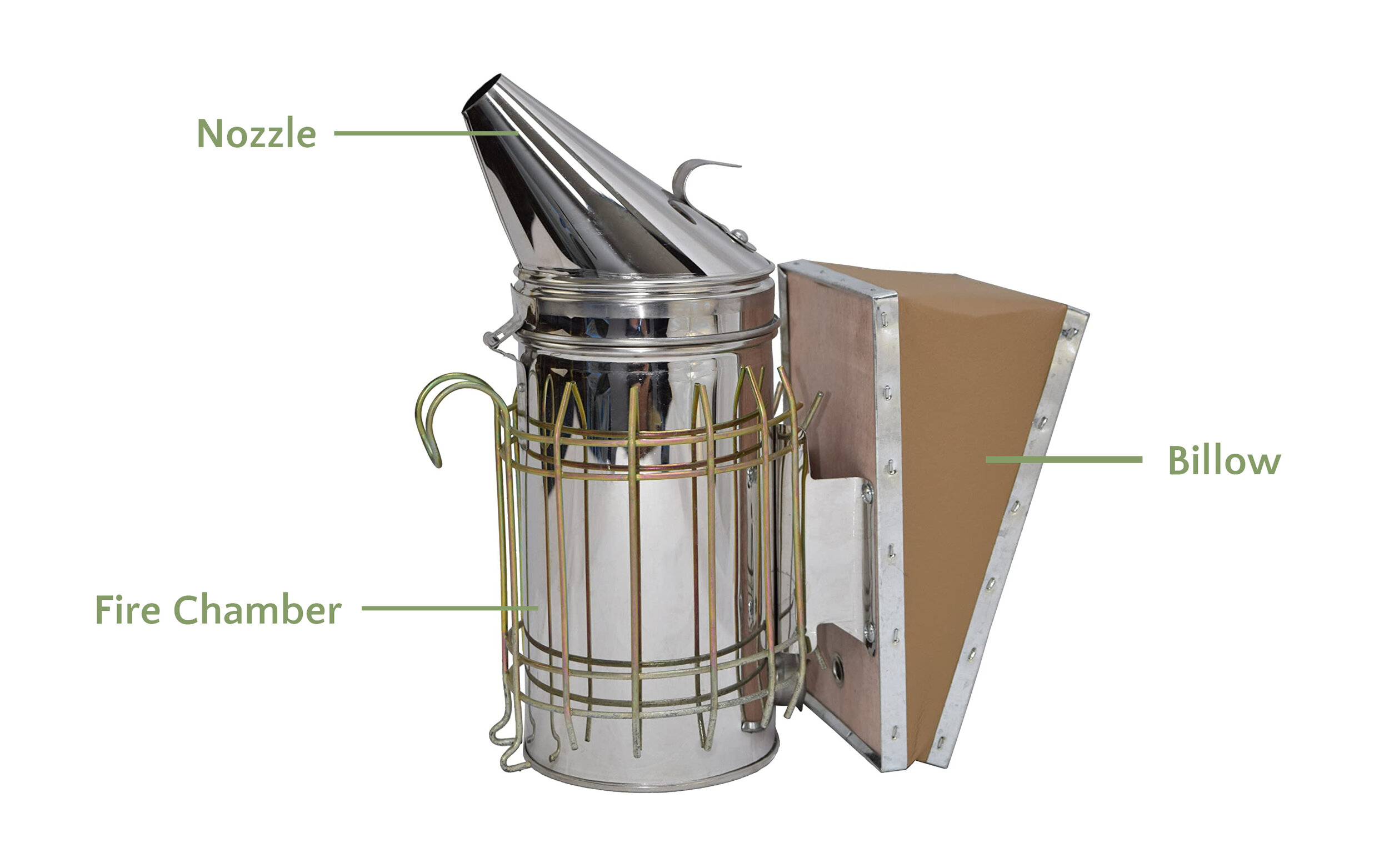Why do beekeepers use smoke?
Have you ever seen a beekeeper use a metal contraption to blow smoke before opening the hive? This device is called a smoker, and it’s an essential tool that keeps bees and beekeepers safe.
We’re often asked, “How do beekeepers avoid getting stung?” In short, it’s by smoking their hives.
Beekeepers use smoke to keep bees calm during hive inspections. When bees sense danger, they release an alarm pheromone called isopentyl acetate from a gland near their stingers. This chemical wafts through the air and alerts other bees to be ready to attack. Smoking a beehive masks this pheromone, allowing the beekeeper to safely perform a hive inspection.
What is a bee smoker?
A bee smoker is the device beekeepers use to puff smoke into their hives. This smoke doesn’t harm bees, it just interferes with their sense of smell so that they don’t react to alarm pheromones. Bee smokers are usually referred to as “smokers” for short.
A smoker consists of three main parts: the bellow, nozzle, and fire chamber. The bellow attached to the fire chamber allows you to restrict the flow of oxygen. This means you can keep your smoker lit for a long time and control the smoke. Just squeeze the bellow to get a puff of smoke from the nozzle.
It’s hard to believe there was ever a time where beekeepers worked without smokers! But it wasn’t until 1873 that Moses Quinby, the father of American beekeeping, first invented the smoker.
What does smoke do to bees?
Most people think smoke makes bees “sleepy.” This isn’t exactly accurate. The smoke actually masks bees’ alarm pheromones.
Smoke causes bees to prepare to leave their hive because they believe it is on fire. They begin to eat lots of honey, thinking they need the energy to go find a new home. Engorged with honey, their abdomens are so full it makes it hard for them to sting. (Imagine the feeling of bending down to tie your shoe after a big dinner.)
As long as the smoke is not too hot, it does not harm bees. I always puff some smoke onto my arm to make sure it’s cool to the touch.
Beekeepers inspect their hives to ensure they’re healthy. The goal is never to harm the colony.
Imagine trying to talk to your friends over the sound of loud music. This is similar to the experience a colony has when a beekeeper smokes the hive. The bees' sense of smell is disrupted by the smoke, so they can’t communicate.
What is the smoke beekeepers use?
The smoke beekeepers use can come from a variety of fuels such as burlap, pine needles, wood pellets, twigs, or cardboard. The role of smoke is to calm bees, therefore you should never use synthetic materials or paper that’s been bleached as it can irritate the bees.
Good smoker fuel burns slowly, lights quickly, and most importantly, produces smoke. Strong chemical smells can be harmful to bees. If you lite your smoker and get an acrid smell, find a new fuel.
Many shops sell smoker fuel, but it’s easy to find for free at home.
I’m lucky enough to have a yard waste collection service in my neighborhood. This means every so often, I can just go into my neighbor’s trash and collect buckets full of pine needles—the perfect fuel for a smoker.
A good beekeeper always has a store of smoker fuel at the ready. There are few things less frustrating than needing to rummage around the garden for fuel before opening the hive.
Tips for how to smoke your hive
The best inspection is one where you and the bees feel safe. Stings can kill bees and sure aren’t fun for humans! That’s what makes smokers so important. Here’s how to use one properly:
Pack plenty of fuel into the smoker. You don’t want it to go out in the middle of an inspection.
Puff a bit of smoke at the entrance of the hive prior to opening the cover. Think of this as letting your bees know, “Hey, I’m coming in!”
Smoke isn’t a substitute for being gentle, calm, and smart. Be mindful when inspecting bees and only work the hive on days with good weather.
Don’t use too much smoke. Unless you’re working with a particularly aggressive colony, a few puffs is all it takes.
If you get stung, smoke the area. Once a bee stings, you can be certain others will get upset and begin to sting too. This is where smoke helps.
Where can I buy a honeybee smoker?
You can purchase beekeeping smokers online. They usually run around $20 and come in a few shapes and sizes, but really, they all work the same. I bought mine on Amazon for $15.99. I use it during every inspection and during our hands-on beekeeping experience that we offer to the public.
Here’s the link:
Our blog and beekeeping podcast is supported by readers like you. If you use the link above to buy your smoker, we’ll get a small payment at no additional cost to you.
Wherever you decide to buy your smoker, look for the kind with a metal cage around the outside. This is known as a heat shield and it goes a long way in preventing burns. Plus, most heat shields have a small hook that makes it easy to store your smoker.



